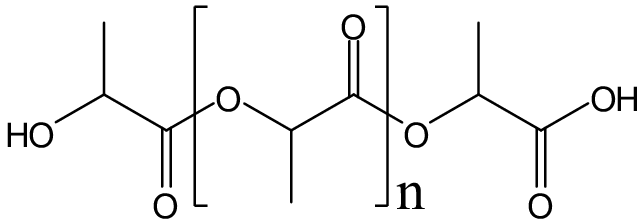PLA: The Most Promising Biodegradable Plastic

PLA (polylactic acid) is a new type of degradable material, which can be obtained by extracting starch from renewable plants, then biologically fermented to obtain lactic acid, and finally prepared by chemical synthesis. PLA has good degradability and can be completely degraded by microorganisms. Products made of PLA can be completely degraded into CO2 and water after use, and are non-toxic and non-irritating.
PLA has mechanical properties similar to polypropylene, while its gloss, clarity and processability are similar to polystyrene, and its processing temperature is lower than that of polyolefin. The processing method of plastic is processed into various packaging materials, fibers and nonwovens, etc., which are widely used in industrial, agricultural, medical and civil fields.
The preparation method of PLA can be generally divided into direct polycondensation method and ring-opening polymerization method (lactide method). The direct polycondensation method, also known as the PC method or the one-step method, uses the activity of lactic acid to remove carboxyl and hydroxyl groups in the presence of dehydration groups, so that the lactic acid molecules are polycondensed to form low-molecular polymers, and then the molecules are directly dehydrated by high temperature. One of the processes to condense PLA into PLA is usually melt polymerization, solution polymerization and melt-solid phase polymerization, among which melt polymerization is the most widely used.
The ring-opening polymerization method is also called the ROP method, that is, the lactic acid monomer is first dehydrated and cyclized to synthesize lactide, and then the recrystallized lactide is polymerized to obtain PLA. This method can obtain PLA with extremely high molecular weight. It is about 700,000 to 1 million (low molecular weight PLA can be rapidly degraded, which is conducive to drug release and is suitable for the medical field; high molecular weight PLA has important commercial value in the fiber, textile, plastic and packaging industries), so it is the current industrial The polylactic acid synthesis process mainly used in the above.
Polylactic acid has high strength, high modulus, and good transparency and air permeability, but its crystallization rate is too slow during processing, which leads to prolonged processing cycle and poor heat resistance, which greatly limits the application field of polylactic acid products. . At present, the most common way to improve the performance of polylactic acid is to add a nucleating agent, and in actual enterprise processing applications, talc is the most commonly used inorganic nucleating agent for polylactic acid, which can improve the stretching and bending of polylactic acid, etc. Mechanical properties, improve its heat resistance.
At present, the global PLA production capacity is about 653,500 tons, and the main PLA manufacturers are mainly concentrated in the United States, China, Thailand, Japan and other countries. American Nature Works is the world’s largest PLA manufacturer, with an annual production capacity of 180,000 tons, accounting for about 30% of the global PLA production capacity. The production of PLA in my country started relatively late, and the main raw materials of lactide mainly rely on imports. Due to technical reasons or lack of raw material lactide, some PLA plants cannot operate stably or are in a shutdown state. The actual effective production capacity is about 48,000 tons/year, and the output is about 18,000 tons/year.
PLA has a wide range of applications and has been successfully used in plastic packaging, biomedicine, and textile fibers. The harmless properties of PLA make it have broad application prospects in the field of packaging, mainly used as food packaging, product packaging and agricultural mulching films. PLA has a smooth surface, good transparency and excellent barrier properties, and can completely replace PS (polystyrene) and PET (polyethylene terephthalate) in many places, thereby reducing the problem of plastic pollution. PLA degradable fiber integrates degradability, moisture conductivity and flame retardancy, as well as molding, application and degradability, and is widely used in the field of textile fibers. At the same time, PLA has excellent biocompatibility and good physical properties. After its degradation, it generates carbon dioxide and water, which is harmless to the human body and can be degraded naturally. Therefore, PLA is increasingly used in the field of biomedicine, such as tissue consolidation (such as Bone screws, fixation plates and plugs), wound dressing (eg artificial skin), drug delivery (eg diffusion control), and wound closure (eg application of sutures).
